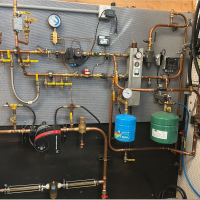Pressure/Booster Pump for Residence with Low Water Pressure & Flow
We purchased a house that use to have well water but now has city water supply. The static water pressure is 40 psi. The house has a main level with bath , kitchen, laundry, and an upper level with a bath. The flow rate when any two fixtures are used is very low and slow. Taking two showers at the same time is almost not possible. The Water Company did change the meter but without any improvement. So, I am looking at an automatic pressure booster pump that would be connected to the 3/4" supply pipe and set for 50-60 psi. Grundfos has a Scala series that seems a good choice. Any comments or concerns or recommendations. Thanks
Comments
-
If your static pressure is around 40 psig, that is ample. What you are seeing, though, is somewhere in your system there is a big flow restriction. Without going over the plumbing rather carefully, it's hard to say what — but it could be as simple as a partly closed valve somewhere.
Before you go the expense and trouble of putting in a booster, you need to find that restriction — because if the booster is on the low pressure side of the restriction, it will work poorly if at all. They are designed to take ample water, but at low pressure, and boost that — but you don't have ample water.
Br. Jamie, osb
Building superintendent/caretaker, 7200 sq. ft. historic house museum with dependencies in New England1 -
Former municipal water system Engineer here:
@Jamie Hall is 100% correct. Your problem is likely coming from within the house. Worst case it is the service pipe to the house - see below:
40psi is more than enough for a house service.
20 psi is considered "acceptable" - mostly for fire service, but even at that pressure, you should be able to get water anywhere in a one-story house.
Now the technical part.
For municipal water flow, there are three important variables: Static Pressure, Residual Pressure, and Flow.
- Static pressure is the pressure at the pipe with no flow - this is almost certainly the 40 psi you are measuring.
- Residual pressure is the pressure with the water flowing - this would be the drop you'd see at your meter when water is turned on.
- Flow rate is simply the volume of water in gallons per minute, which helps make sense of static and residual pressures.
It is possible to have a high static pressure (say 100 psi) and a low residual pressure (say 30 psi). In these cases, you often have low flow rates - this is one possible scenario in your case, but I would say it is extremely unlikely unless your service is off of a 2" domestic main or very, very long (more than 500ft or so); see the next section below.
In another case, it is possible to have low pressure (say 35 psi) and nearly equal residual pressure (say 34 psi). This was a common case in my gravity-fed municipal system as it is well-gridded with large diameter pipes.
Most results, of course, are somewhere in the middle.
Where are you?
I'm going to make some assumptions: your municipal system also supplies fire hydrants. If so, then you are supplied by a 4" or, more likely, a 6" or 8" water main. These mains carry far more water than a home can use. A nominal fire supply is 1,000 gpm or more, and certainly exceeds 500 gpm. To supply that fire load, the water main must have more than enough water to serve a house.
Assuming a 3/4-inch copper line, the nominal flow at 40 psi is 12 gallons per minute (gpm). As 5 gpm is the minimum considered acceptable, unless your fixtures have exceptionally high flow rates, you should have sufficient water.
To put it simply, you should have more than enough water coming into your home. Any problems would be past the meter, not the meter.
One final caveat: if your 3/4" service is plastic, then you may not have enough flow; it is actually closer to a 1/2-inch copper pipe. As this connection to the City Water is new, I'd question why they even allowed such a small service.
0 -
pictures of some of the piping in the basement would help.
is it all copper?
0 -
-
Thank you for all your comments. Took some pressure readings. I have a hose bib inside the house just after the main 3/4" gate valve and an outside hose bib within 5' of the inside bib. The static pressure is 44 psi and with the outside bib fully open, the pressure drops to 36 psi. Have not measured the flow rate outside but think it's about 8-10 gpm. We live on a dead end lane that is about 1000' long from the cross street. The houses on the lane have a mix of well water and city water. Our house is 500' from the cross street. Our previous owner and and our neighbor paid to be connected to city water. There is a fire hydrant on the lane about 200' from the cross street. Our meter is in a below ground pit 100' from the inside house main valve. Any comments?
0 -
Also, we had a new Moen kitchen faucet installed recently. The faucet flow rate is spec'd 1.5 gpm @ 60 psi. I have a flow rate of 1 gpm with no other taps open.
0 -
-
@ what presure?
0 -
And your pressure at the house is 40 psig? Not surprising… that's pretty much what I would expect.
And you have a clue: that outside hose bibb runs a good flow (I'd be surprised if it were 10 gpm, but it might be… that's a lot for a hose bibb, though) so you have adequate flow and pressure to the house. What's the flow at the inside hose bibb just after the main gate valve? That might be nice to know…
Br. Jamie, osb
Building superintendent/caretaker, 7200 sq. ft. historic house museum with dependencies in New England0 -
-
pecmsg: You asked at what pressure? Probably around 40-42 psi. The static(no flow) pressure is 44 psi; so a flow rate of 1 gpm would probably cause a 2 psi pressure drop in the piping to the kitchen faucet resulting in 40-42 psi at the faucet which is consistent with the spec of 1.5 gpm at 60ps
Jamie Hall: The outside hose bib is connected to the 3/4" main water line through about 2' of 1/2" copper and a ball valve. According to copper pipe data books, a 10 gpm flow through 2' of copper would result in a pressure drop of about 1.25 psi. so, the flow from the inside hose bib would be maybe 5-10% higher than from the outside bib.
Mad Dog; Did some checking on 3/4" copper pipe pressure drop. At 10 gpm, there is a pressure drop of about 10psi/100' of pipe. My inside gate valve is approximately. 100' from the water meter at the street. This is consistent with me seeing a pressure drop from 44 psi (static )to 36 psi when I fully open the outside hose bib closest to the main gate valve.
At of this data indicated to me that the solution would be to add a pressure/booster pump in the supply line in the basement. Maybe in hindsight, there should have been 1" copper pipe from the meter to the house to reduce the pressure drop in the water main but I have what I have.
As a point of reference, the house we recently sold, had a static water pressure of 90 psi. I had to install a pressure regulator set for 60psi to reduce some god awful water hammer from the washing machine. I had an outside 3/4"hose bib before the pressure regulator and was able to run about 12 gpm through my lawn sprinklers with no problem.
0 -
I'm not interested in what the book says about the inside hose bibb. What does it actually do?
Br. Jamie, osb
Building superintendent/caretaker, 7200 sq. ft. historic house museum with dependencies in New England0 -
that sounds about right. Rated at 1.5GPM@60PSI
Delivering 1 GPM @40 psi.
0 -
I have a three-quarter inch PVC line coming in line coming in at 45 psi (who know why). Two people and take showers time with low flow heads, no issues.
If someone turns on either one of the two vintage tubs faucets, neither shower is going to get more than a dribble. Water is lazy, it always takes the easiest path.
0 -
Do you have a pressure reducing valve? If so did you check the strainer in the PRV? That is a common place to look for reduced flow.
Design criteria for a PRV is based on drop-off pressure. Ideally 7.5- gpm with a full load running.
If you knew the pressure at the main, before a PRV?
Here is an example of a fall off chart for sixing PRV. This 1/2" example is a common valve in small condo projects, single bath type use, 8 gpm max flow.
Bob "hot rod" Rohr
trainer for Caleffi NA
Living the hydronic dream0 -
Hi, I'll add that you might want to look into pressure compensating areators. They give the same flow over a range of pressures. Neoperl is the manufacturer. I'd be looking at low flow, like1.5 gpm and pressure compensating. Showerheads can be had with this technology also. Might help prevent jumping around when someone flushes a toilet without warning. 🙀
Yours, Larry
0 -
Hot Rod, No PRV installed in this house.
Larry Weingarten, Thanks for the information on pressure compensating aerators. Did not know they were available. Cleaned out the aerator in the new kitchen sink faucet and removed a lot of stuff and the flow is better. Need to check other fixtures for dirty aerarots.
1 -
Categories
- All Categories
- 87.3K THE MAIN WALL
- 3.2K A-C, Heat Pumps & Refrigeration
- 61 Biomass
- 427 Carbon Monoxide Awareness
- 119 Chimneys & Flues
- 2.1K Domestic Hot Water
- 5.8K Gas Heating
- 115 Geothermal
- 165 Indoor-Air Quality
- 3.7K Oil Heating
- 76 Pipe Deterioration
- 1K Plumbing
- 6.5K Radiant Heating
- 395 Solar
- 15.6K Strictly Steam
- 3.4K Thermostats and Controls
- 56 Water Quality
- 51 Industry Classes
- 49 Job Opportunities
- 18 Recall Announcements








